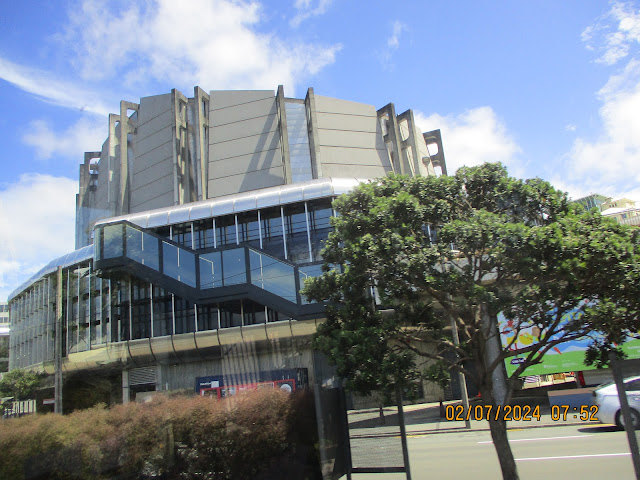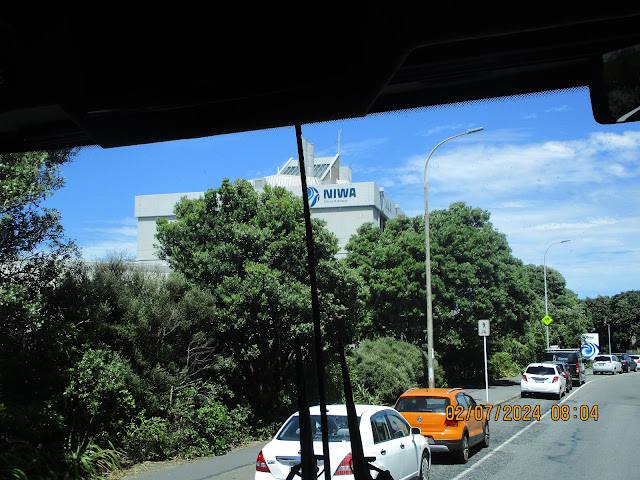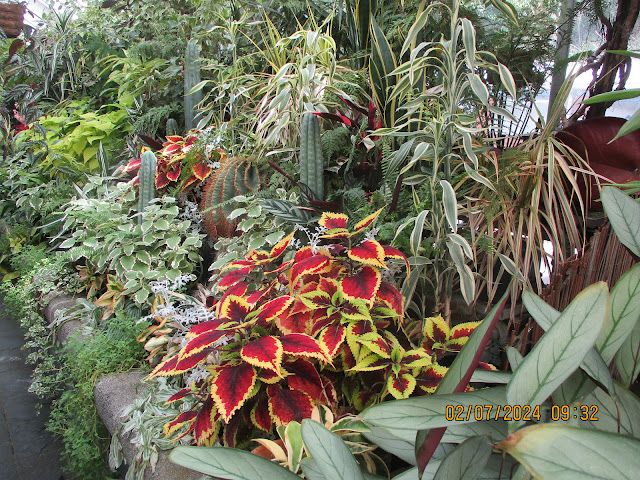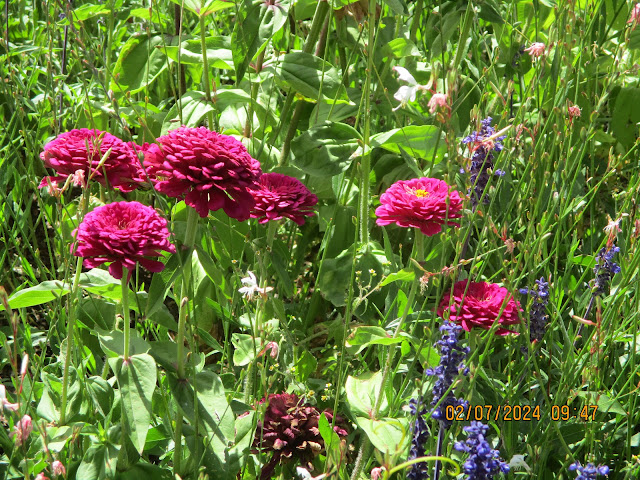Tolin's 2024 World Cruise blog posts, Day 29 Feb 7, 2024, Botanic Gardens and Cable Car Ride, Wellington, NZ
Wellington is the capital city of New Zealand. It is located at the south-western tip of the North Island, between Cook Strait and the Remutaka Range. Wellington is the third-largest city in New Zealand, and is the administrative center of the Wellington Region. It is the world's southernmost capital of a sovereign state. Wellington features a temperate maritime climate, and is the world's windiest city by average wind speed.
Māori oral tradition tells that Kupe discovered and explored the region in about the 10th century. The area was initially settled by Māori iwi such as Rangitāne and Muaūpoko. The disruptions of the Musket Wars led to them being overwhelmed by northern iwi such as Te Āti Awa by the early 19th century.
Wellington's current form was originally designed by Captain William Mein Smith, the first Surveyor General for Edward Wakefield's New Zealand Company, in 1840. Smith's plan included a series of interconnected grid plans, expanding along valleys and lower hill slopes. The Wellington urban area, which only includes urbanized areas within Wellington City, has a population of 215,200 as of June 2023. The wider Wellington metropolitan area, including the cities of Lower Hutt, Porirua and Upper Hutt, has a population of 440,900 as of June 2023. The city has served as New Zealand's capital since 1865, a status that is not defined in legislation, but established by convention; the New Zealand Government and Parliament, the Supreme Court and most of the public service are based in the city.
Wellington's economy is primarily service-based, with an emphasis on finance, business services, government, and the film industry. It is the center of New Zealand's film and special effects industries, and increasingly a hub for information technology and innovation, with two public research universities. Wellington is one of New Zealand's chief seaports and serves both domestic and international shipping. The city is chiefly served by Wellington International Airport in Rongotai, the country's second-busiest airport. Wellington's transport network includes train and bus lines which reach as far as the Kāpiti Coast and the Wairarapa, and ferries connect the city to the South Island.
Often referred to as New Zealand's cultural capital, the culture of Wellington is a diverse and often youth-driven one which has wielded influence across Oceania. One of the world's most livable cities, the 2021 Global Livability Ranking tied Wellington with Tokyo as fourth in the world. From 2017 to 2018, Deutsche Bank ranked it first in the world for both livability and non-pollution. Cultural precincts such as Cuba Street and Newtown are renowned for creative innovation, "op shops," historic character, and food. Wellington is a leading financial center in the Asia-Pacific region, being ranked 35th in the world by the Global Financial Centers Index for 2021. The global city has grown from a bustling Māori settlement, to a colonial outpost, and from there to an Australasian capital that has experienced a "remarkable creative resurgence"
Wellington was declared a city in 1840, and was chosen to be the capital city of New Zealand in 1865.
Wellington became the capital city in place of Auckland, which William Hobson had made the capital in 1841. The New Zealand Parliament had first met in Wellington on 7 July 1862, on a temporary basis; in November 1863, the Prime Minister of New Zealand, Alfred Domett, placed a resolution before Parliament in Auckland that "... it has become necessary that the seat of government ... should be transferred to some suitable locality in Cook Strait [region]." There had been some concerns that the more populous South Island (where the goldfields were located) would choose to form a separate colony in the British Empire. Several commissioners (delegates) invited from Australia, chosen for their neutral status, declared that the city was a suitable location because of its central location in New Zealand and its good harbor; it was believed that the whole Royal Navy fleet could fit into the harbor. Wellington's status as the capital is a result of constitutional convention rather than statute.

Wellington is New Zealand's political centre, housing the nation's major government institutions. The New Zealand Parliament relocated to the new capital city, having spent the first ten years of its existence in Auckland. A session of parliament officially met in the capital for the first time on 26 July 1865. At that time, the population of Wellington was just 4,900.
More info: https://en.wikipedia.org/wiki/Wellington
For over 120 years, the Cable Car has trundled up and down the Kelburn hillside. Ferrying commuters, students, and tourists between Lambton Quay, Victoria University, and the Botanic Gardens. The five-minute trip has become a Wellington must-do for tourists.
Every 10 minutes, the bright red Wellington Cable Car departs from Lambton Quay and makes its way up into the hills of Kelburn.
The 675 yard journey travels through three tunnels and over three bridges. Once you’ve reached the top you’ll have risen 1,000 feet above sea level. The views of the city below and harbor and hills beyond are, predictably, spectacular.
more info: https://www.wellingtonnz.com/visit/see-and-do/wellington-cable-car
The area where the Botanic Garden now sits has been an important site for generations. When Europeans arrived, there were already well established pā at Pipitea and Kumutoto. The people of Te Ātiawa from Pipitea Pā used the Botanic Garden for ngākinga (food cultivation), collecting native plants for construction, food, fibre, and medicine, and birds for food.
Te Ātiawa used large areas of the garden, and nearby hill Te Ahumairangi, for their own use and for trading until they were displaced from their pā in the mid-1800s.
Growth of the garden
In 1844, the New Zealand Company set aside a 5.26 hectare strip of land to start a botanic garden reserve. At that time the area was covered in dense podocarp forest including rimu, totara, and mataī.
The official Wellington Botanic Garden was established in 1868, with the Botanic Garden Bill passed in 1869. The management of the gardens was passed on to the New Zealand Institute.
Wellington City Council has managed the Botanic Garden since 1891.
The Wellington Botanic Garden showcases plants from all over the world. There are gardens dedicated to Australian plants and Southeast Asian camellias, tulips and succulents, European conifers and native hīnau (some of which have been there since before Wellington was settled in the 1800s). Highlights include the Lady Norwood Rose Garden—a sprawling formal rose garden arranged around a fountain, with more than 3,000 roses—and the Begonia House, a hothouse with a wide range of tropical flowers and tuberous begonias. Explore these gardens while walking the area’s many paths, which are suitable for people of almost all fitness levels. Bring the kids to the Discovery Garden, where they can learn about the plants around them and how to take care of their own environment.
Many travelers discover the garden’s many secrets on a garden tour, held on the third Sunday and fourth Monday of each month. Some small-group and bus city sightseeing tours stop here to experience the rose garden and Begonia House.
More info: https://www.viator.com/Wellington-attractions/Wellington-Botanic-Garden/overview/d399-a2384#overview












































































Comments
Post a Comment